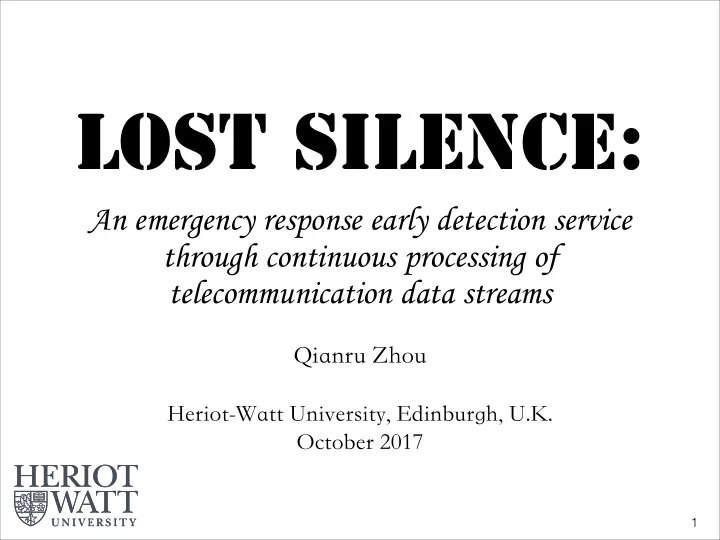

Lost Silence: An emergency response early detection service through continuous processing of telecommunication data streams Qianru Zhou Heriot-Watt University, Edinburgh, U.K. October 2017 1
Motivation At 21:30 on 1st June, 2015, on the Yangtze River, in Jianli, Hubei, China, the cruise ship “Eastern Star” ship capsized with 458 passengers and crew on board. No distress signal was sent. It was several hours before the emergency services became aware of the tragedy and 442 lives were lost. 2
\ 3
When a ship capsizes, is there any way to detect this as soon as it happens? The Answer is YES ! This can be carried automatically in Real Time via RDF STREAM PROCESSING … 4
What I am really doing … Building knowledge based autonomic network management system for hybrid telecommunication networks. 5
Some Basic Telecommunication Knowledge 6
Challenges Telecommunication networks are HETEROGENOUS • Hybrid access technologies. - WiFi, LTE, 3G/2G, Satellite, Mesh, etc… • Hybrid data schemas from different service providers/vendors. • The data in real telecommunication system are extremely dynamic. - E.g., system log, SNMP polling, tcpdump, and configuration data, etc. - The granularity of SNMP, Syslog and tcpdump update period is in terms of a few seconds, one second and microseconds, respectively By annotating the data with RDF/OWL vocabularies, we can present real time information as streams of uniformly RDF encoded linked-data . 7
Ontology Adopted in Lost Silence 8
An Example … To describe the fact that “a phone lost signal at location (329.860, 246.792)” 9
A Uniformed Spatial Segmentation — Geo Pixel • Defined based on the third decimal degree of the latitude and longitude coordination • Resolution: 0.001 ◦ × 0.001 ◦ , or 100m × 100m. 10
Simulation Scenario We outline a scenario based on the cruise ship “Eastern Star” capsizing on the Yangtze River, in Jianli, Hubei, China, 1st June, 2015. 11
Simulation Scenario • Approx. 286,000 phones in the city covering an area of 373.520 km2 • The mobile phones penetration rate is 96.7% in China, 12
The C-SPARQL query string to detect lost phones 13
Possible Reasons for False Alarms … • Blind Zones - Regions have no or limited signal coverage. - could be avoided by a simple comparison to the list before an alert is sent. • Multiple Phones deliberately damaged - For example, secret dealing, illegal trading, etc. - Worth sending alarms anyway. 14
Results - 5 seconds The number of lost phones of the whole city found by all threads. The total number of lost phones in the city, shown as circles. 15
Results - 20 seconds The number of lost phones of the whole city found by all threads. The total number of lost phones in the city, shown as circles. 16
Results - 30 seconds The number of lost phones of the whole city found by all threads. The total number of lost phones in the city, shown as circles. 17
Results - Pressure Test A pressure test is also carried out to simulate an extreme scenario in which 10 ships capsize in different locations on the river simultaneously, As shown in the Fig below, the abnormality of a large number of lost phones in all of the 10 geo-pixels are detected, and alerts are sent successfully. 18
Conclusions • Heterogenous telecommunication data are concentrated and formatted. • Continuous RDF processing for phone data streams querying in real time. • Simulation based on a real life shipwreck incident. 19
Recommend
More recommend